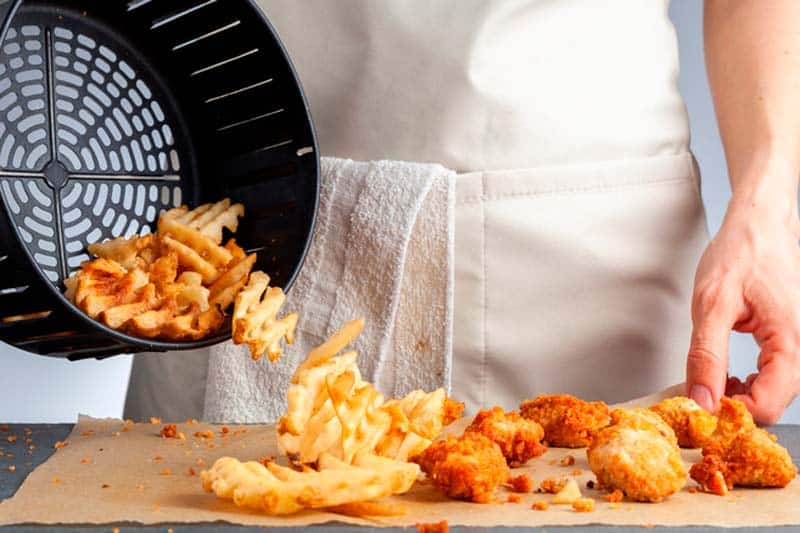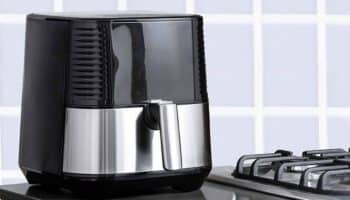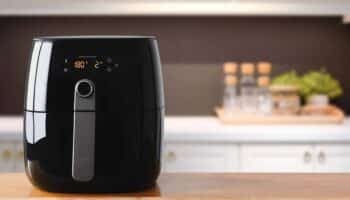If you’ve just hopped on the latest kitchen appliance bandwagon, you might be wondering about the maintenance and best practice guidelines for air fryers.
Yes, there are lots of places online that have bits and pieces of information here and there, but I decided to spend some time researching everything and curate the most important bits here. Because we’re all about making things easier for our readers.
Air fryer maintenance includes regular cleaning, avoiding utensils that can scratch nonstick coating, using the right oil and not too much of it, never overcrowding your basket, shaking or flipping your food halfway through the cooking cycle, and adjusting cooking times and temperatures as necessary.
That’s the bare bones of it, now let’s flesh it out a little bit.
How to Maintain Your Air Fryer
I’ll do my best to cover everything here, but the best thing you can do is read your owner’s manual. It will give you specifics with regards to your own unit in contrast to what you read here, which will be generalizations.
I’ll first cover best practices in keeping your air fryer clean and working properly, and then I’ll cover best practices while using or cooking with your air fryer.
Regular Cleaning. Keeping your air fryer clean is a simple but effective way of adding life to your unit. If you decide to clean after each use, this will go a long way in preventing a buildup of residue and grease.
At the most, you should clean it after every few uses. That means if you use it every day of the week, you’ll need to clean it two or three times a week.
Follow the steps below to keep your air fryer in optimal condition.
Remove buildup. Start by using a soft cloth or paper towel to rub off any baked-on grease and food particles from the bottom of your baskets.
Clean the tray/rack. Apply the same method used for the baskets to clean your grill tray. Be cautious when dealing with nonstick coating to avoid scratching or damaging the surface. Use soft brushes to clean any spots that are difficult to reach.
Soak and clean with soap and water. After removing most of the residue, soak your basket in warm soapy water. Use a soft sponge, brush, or cloth to thoroughly clean the interior of the basket and tray.
Dry completely. Leave the basket and tray on the counter to air dry while you proceed to the next step.
Remove interior grease buildup. Due to the circulating air during cooking, grease and food particles may accumulate on the interior walls and heating element. Use a damp sponge or dishcloth along with a little dish soap to scrub down the interior of your air fryer.
Rinse and dry. After removing all the grease, rinse the interior of the unit to eliminate any soap residue. Wipe it dry with a clean cloth.
Wipe down the heating element. Flip your air fryer upside down and use a damp sponge or cloth — without soap — to clean the heating element. Make sure to dry it thoroughly to prevent rusting.
Reassemble. Once all the interior components are dry, reassemble your air fryer. Wipe down the exterior to give it a clean and sparkling appearance in preparation for your next meal.
Key Takeaways
I want to highlight some key takeaways from the above. These are important points that shouldn’t be overlooked.
- Clean after every use or after every few uses. This means if you use your air fryer every day of the week you need to clean it two or three times per week.
- Never use abrasive materials or cleansers.
- After each cleaning, make sure every part of the unit is completely dry before reassembling.
Best Practices When Cooking with an Air Fryer
Now that we’ve covered how to clean and maintain your air fryer, let’s look at all the best practices to follow while cooking.

If you’re misusing your air fryer, you can damage it or impact its lifecycle. Additionally, using your air fryer correctly can impact the quality of your food. Let’s break it down and deal with best practices for the unit itself. The following list will cover both aspects.
Air Fryer Best Practices
The very first best practice is keeping it clean, but since we’ve covered that in depth above, I’ll just make a mention of it here.
Keep it clean. For a step-by-step walk-through of how to clean and maintain your air fryer please see the How to Maintain Your Air Fryer section above.
Avoid abrasive cleaners. To prevent scratching the surface — especially any nonstick coating — avoid using any type of abrasive cleaner including steel wall or harsh chemicals when cleaning your air fryer. Always use a mild dish soap that has excellent grease cutting capabilities and a non-abrasive sponge or cloth.
Use oil sparingly. Avoid using excessive amounts of oil in your air fryer, as it can drip or splatter against the heating element. In most cases, a light spray of oil — or none at all — is sufficient, depending on any specific recipe. Be mindful that the circulating air in your air fryer can fling oil onto the heating element, regardless of its position.
Additionally, refer to the user manual of your air fryer for recommended oil quantities. It may have some guidance on the best amount of oil to use.
Opt for oils with high smoke points. Select an oil with a high smoke point, as using oils with low smoke points can result in quick and sometimes excessive smoke production. The smoke point refers to the temperature at which the oil starts to break down and produce smoke.
Choosing an oil with a high smoke point ensures a minimal chance of smoke formation, depending on the cooking temperature. Additionally, choosing an oil with a mild flavor ensures you won’t change the taste of your food while cooking.
Here are several excellent alternatives:
- Avocado oil with a smoke point of 520°F / 271°C
- Light olive oil with a smoke point of 465 – 470°F / 240 – 243°C
- Clarified butter (ghee) with a smoke point of 482°F / 250°C
- Sunflower oil with a smoke point of 450°F / 232°C
- Peanut oil with a smoke point of 450°F / 232°C
Use appropriate cookware. Most air fryers come with a non-stick basket or tray. Avoid using metal utensils or abrasive materials that can damage the non-stick coating. Opt for silicone, wooden, or plastic utensils instead.
This doesn’t mean you absolutely can’t use your metal utensils. You can, but you just need to be very cautious when using them. One slip or fumble, and you could damage your basket or tray.
Don’t overcrowd the basket. Avoid overcrowding the basket with food. Overcrowding your air fryer can hinder proper airflow, leading to uneven cooking. Leave enough space between food items for the hot air to circulate effectively.

Preheat the air fryer. Many recipes recommend preheating the air fryer before adding the food. Preheating helps to ensure even cooking and crispier results. However, not all air fryers have a preheat function, and not all recipes require preheating.
In this case, you may have to use a little bit of trial and error to determine whether or not your air fryer requires preheating.
Shake or flip your food. To ensure even cooking, shake the basket or flip your food halfway through the cooking process. This helps to distribute heat and promote crispness on all sides.
Most recipes will tell you to do this, but there may be cases, particularly when you just have a single layer of food on the tray where you don’t need to flip or shake the basket. This is because there is sufficient airflow, so food will get cooked on all sides.
Adjust cooking times and temperatures. All air fryers are not created equal, so they’ll vary in terms of temperature accuracy and cooking times. It’s advisable to start with the recommended times and temperatures in recipes, but you may need to adjust them slightly based on your specific model and personal preferences.
This is something that many who are new to air fryers are not aware of. Just because you found a recipe online that says to cook a certain item at 375° for 13 minutes, that doesn’t mean those settings will work for you and your air fryer.
Better air fryers typically come with a recipe book so refer to that to get yourself started cooking with your air fryer as it will have the right time frames and temperatures for you.
Key Takeaways
- Use oil sparingly and use an oil without high smoke point
- Choose a neutral flavored oil
- Avoid metal utensils
- Don’t overload the basket
Conclusion
There you have it, everything you need to know to maintain your air fryer and all the best practices to keep it working in optimal condition.
To recap, you’ve learned that you need to keep your air fryer clean and follow best practices such as avoiding anything that could damage your nonstick coating, avoid oils with a low smo’ke point and instead use high smoke point oils, never overcrowd your basket, and understand that at times you may need to adjust cooking times and temperatures.
Follow these steps and your air fryer should last you a long time.
While you’re here, why not check out our related posts below? Perhaps we can help you with something else.







